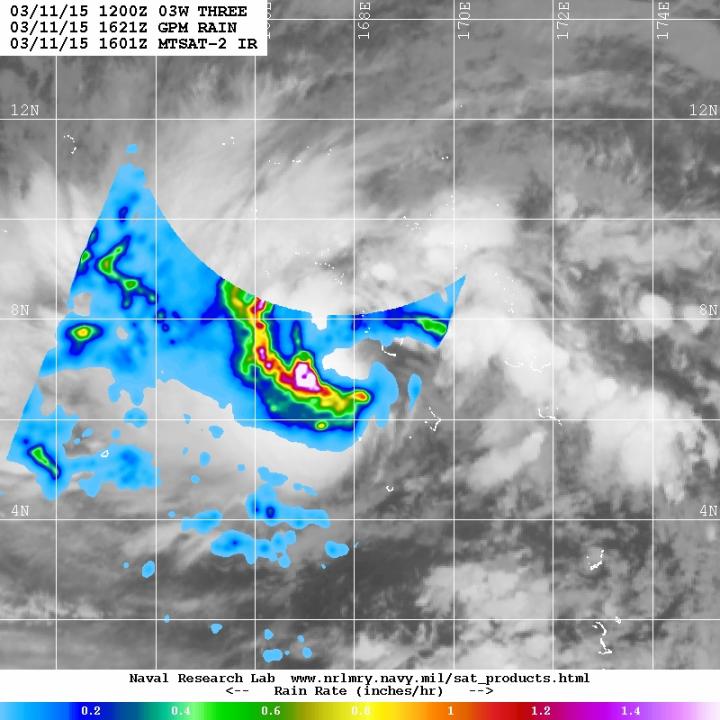NASA-JAXA's GPM sees birth of Tropical Depression 3W in northwestern Pacific

NASA-JAXA's GPM core satellite saw heaviest rainfall at a rate of 1.6 inches (40 mm) per hour was occurring southwest of TD03W's center on March 11, 12:21 p.m. EDT. Credit: NASA/JAXA/NRL
A tropical storm watch was already in effect on March 11 for Ujae and Ailinglaplap atolls in the western Marshall Islands.
The Global Precipitation Measurement or GPM core satellite gathered rainfall data on TD03W when it passed overhead on March 11 at 16:21 UTC (12:21 p.m. EDT).
GPM saw that the heaviest rainfall was occurring southwest of the center of circulation where rainfall rates were near 1.6 inches (40 mm) per hour.
On March 11 at 1500 UTC (11 a.m. EST), Tropical Depression 03W (TD03W) formed just 92 nautical miles south of Kwajalein, part of the Marshall Islands.
The center of TD03W was located near 7.2 north latitude and 168.2 east longitude. TD03W's maximum sustained winds were near 30 knots (34.5 mph/55.5 kph).
It was moving to the west at 18 knots (20 mph/33 kph) and is expected to become a tropical storm.
TD03W is forecast to move to the west-northwest toward Guam.
Media Contact
All latest news from the category: Earth Sciences
Earth Sciences (also referred to as Geosciences), which deals with basic issues surrounding our planet, plays a vital role in the area of energy and raw materials supply.
Earth Sciences comprises subjects such as geology, geography, geological informatics, paleontology, mineralogy, petrography, crystallography, geophysics, geodesy, glaciology, cartography, photogrammetry, meteorology and seismology, early-warning systems, earthquake research and polar research.
Newest articles

“Nanostitches” enable lighter and tougher composite materials
In research that may lead to next-generation airplanes and spacecraft, MIT engineers used carbon nanotubes to prevent cracking in multilayered composites. To save on fuel and reduce aircraft emissions, engineers…

Trash to treasure
Researchers turn metal waste into catalyst for hydrogen. Scientists have found a way to transform metal waste into a highly efficient catalyst to make hydrogen from water, a discovery that…

Real-time detection of infectious disease viruses
… by searching for molecular fingerprinting. A research team consisting of Professor Kyoung-Duck Park and Taeyoung Moon and Huitae Joo, PhD candidates, from the Department of Physics at Pohang University…




















